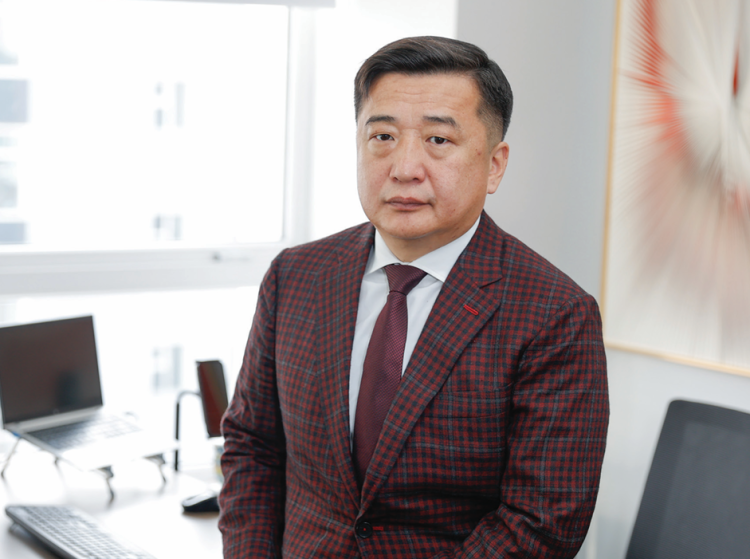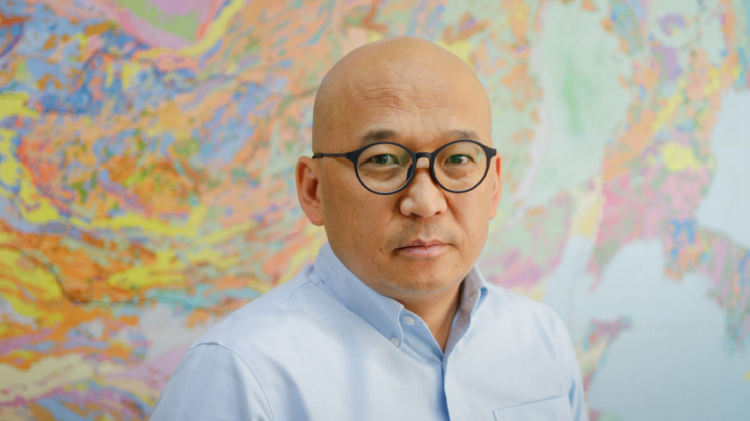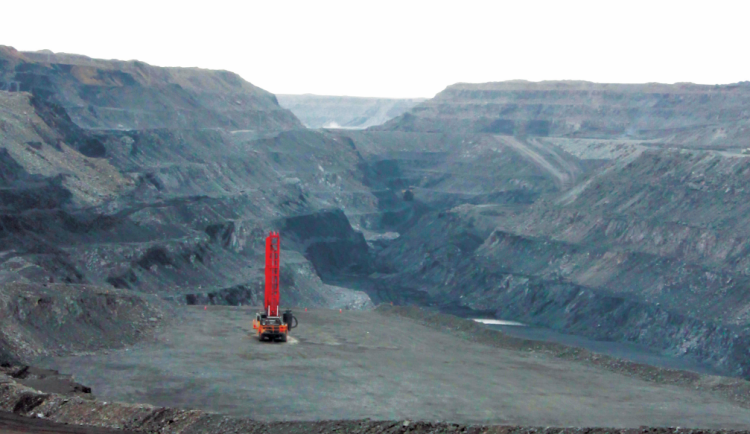 Micheel. E from Mining Insight conducted an interview with His Excellency Mohinder Pratap Singh, the Ambassador Extraordinary and Plenipotentiary of the Republic of India to Mongolia, whose tenure in Mongolia is concluding. Ambassador M.P. Singh shared insights on the bilateral relations and collaboration between the two nations, along with discussing potential opportunities for mining sector development and investments in the oil industry. (2023.11.07)
Micheel. E from Mining Insight conducted an interview with His Excellency Mohinder Pratap Singh, the Ambassador Extraordinary and Plenipotentiary of the Republic of India to Mongolia, whose tenure in Mongolia is concluding. Ambassador M.P. Singh shared insights on the bilateral relations and collaboration between the two nations, along with discussing potential opportunities for mining sector development and investments in the oil industry. (2023.11.07)
First of all, thank you, your Excellency, for accepting our invitation. And as a tradition, would you please kindly introduce yourself?
Well, first of all, thank you to you for having me at this interview. I am M.P.Singh. I think that you know. I have been here now almost five years in Mongolia serving as Ambassador. And this has been an eventful 5-year tenure for me. We have gone through some very interesting phases in Mongolia. To your particular question, my impressions. Before I came here, I liked Mongolia. Now that I am here after five years, I can say I absolutely love Mongolia, its strong and vibrant culture, warm and hospitable people and with a special relationship with India. Our relationship dates back to centuries from Hunnu Empire – our shared heritage defines our historical friendship & ‘spiritual & cultural connect’; our ‘strategic partnership’ is demonstrated by India’s single largest ongoing project for construction of USD 1.236 billion Oil Refinery and construction of ‘Centre of Excellence in IT’ & Cyber Security Training Centre and preparing 1000 English language teachers for Mongolia will shape the ‘promising future’. Before I arrived here, my impression about Mongolia was a distant land of ‘Chinggis Khan’ but after arriving here Mongolia has such a vibrant democratic society, thriving free capital economy, such brave people, cordial, warm, effusive, spiritual, and in almost every aspect they are, very strong. They take pride in maintaining their unique cultural heritage & identity be it Khuumii, or Bielgee, be it Morinkhuur or be it Naadam, and many of its own traditions that makes Mongolia stand apart despite surrounded by overwhelming cultures in the neighbourhood. And Mongolia’s admirable policy of ‘third neighbor’ concept makes even more unique. So in nutshell, I can say that Mongolia is a nation full of promise; the last bastion of untamed nature with exceptionally talented people pursuing its destiny as a strong democracy and thriving market economy.
India and Mongolia are the spiritual neighbors. How would you define this?
In our relationship with Mongolia, which is a very important partner for India in its East policy, four Ds define our contemporary relationship. The first D is Dharma (religion), the second D is democracy. The third D is development partnership & the fourth D is digital development. I can even add that the fifth D that has emerged in recent years as ‘defense cooperation. You can see that these five Ds form the pillar of our traditionally strong relationship in which ‘spiritual connect’ and development partnership’ are the most important. What sustains our relationship today came during historic visit of PM Modi when our relationship was elevated to ‘Strategic partnership’ and a roadmap of economic cooperation was adopted with the signing of over 15 different agreements in various fields. The highlight of our special friendship is that India was the first country in the world to provide Covid Vaccines to Mongolia. For further reinforcing our spiritual & cultural connect with Mongolia, we have taken some very important steps in the recent past that include telecast of 55-episode TV serial on Lord Buddha dubbed in Mongolian language by MNB not once but thrice in 2020 & 2021 & 2022 confirming its popularity. And prior to that, in 2019 summer, Gandan Monastery organization the Asian Buddhist Conference of Peace witnessed participation of the larges and very strong Indian delegation. That was followed by Hindu-Buddhist Samvad on conflict avoidance or Samvad two, an initiative of Prime Minister Modi and Prime Minister Shinzo Abe of Japan which was again organized by Gandan Monastery and was liked by many people. Despite COVID, we have continued to engage to reinforce the spiritual connect, which is one of the strong pillars. Perhaps you are aware that close to about 600-plus Mongolia Monks are currently studying in India, which are also the bridges for reinforcing this cultural part of India with Mongolia. Last year in June 2022, we were able to bring the holy relics of Lord Buddha, which were in exposition for about 10 days in Gandan Monastery. According to some estimates, over 120,000 people paid their respects to the holy relics. We are also in the process of exploring the possibility of bringing in sacred relics of Sariputra and Moggallana, the two very revered disciples of Lord Buddha. In October last year, we arranged distribution of about 60 sets of 108 volumes each of sacred Mongolian Ganjuur to various monasteries. We plan to digitize about 1 million Buddhist manuscripts in Gandan Monastery so as to leave this unique heritage for the future generation. All of these signify that we are trying to strengthen our shared heritage of Buddhism. In the coming months, what we have plans to undertake some more initiatives. All I could say is that we are we are very proud of this strong pillar of our relationship with Mongolia and cooperation in the cultural realm.
The biggest support from India to Mongolia is the investment in the ORP. As of today, all EPCs contracts have been signed. What are the benefits of this project?
Well, to your question, what are the benefits of Oil Refinery Project to Mongolia? You must realize as to how important is energy security to any economy in the world. This USD 1.3 billion first grass root refinery being built in Dornogobi with assistance from India will create an entire sustainable ecosystem for energy independence for Mongolia. Having its own oil, having its own energy security is bound to make Mongolia much more strong to sustain sustainable economy without bothering about fluctuations and challenges of transportation. Secondly, it would produce about 1.5 million metric tons of refined oil which is roughly 75% of Mongolia’s total energy needs. I can give you the numbers; 824,000 tons of diesel, 339,000 tons of petroleum, 80,000 tons of aviation fuel, 43,000 tons of LPG, and 47,000 tons of kerosene fuel, and many byproducts. These are enough for landlocked Mongolia to independently plan use of energy resources without additional cost of transportation. Thirdly, Mongolia’s own Oil Refinery will have positive impact on socio economic development. It will create a conducive environment for industrialization, for Mongolia, which currently is primarily mining-driven economy. With energy independence in place, Mongol refinery could help to expand its economic base much more further. According to some estimates drawn by Mongolia experts, it can add up to 10% to Mongolian GDP. On employment front, it would create thousands of direct and indirect job opportunities in Mongolia. Particularly for the Dornogobi Province, Oil Refinery can create a socio-economic structure where the youth will have much more opportunity A to study locally, B, to become engineers & technicians to serve the Mongol refinery without going out or abroad. Other benefits I can tell you that it will save a substantial amount of foreign exchange to government of Mongolia. Currently, if you look at the statistics issued by NSO, roughly about USD 700 to 800 million worth of Mongolia crude goes to a country, and Mongolia imports about USD 1.2 billion worth of energy needs from another country. So having Oil Refinery in Mongolia would save some hundred million of USD every year. Lastly, it'll also generate revenue for the Government being a state-owned enterprise. These are some of immediate benefits which could have a multiplier effect on economy after Oil Refinery is complete in 2026. Mongolia, using its own crude, perhaps, could also look at reducing the domestic prices of oil and diesel, by utilizing the savings on account of transportation of foreign oil and additional revenue to state exchequer.
Mongolia is about to have its own oil refinery. And there is a shortage of expertise. Once the plant is operational, will Indian experts come to work at the early stage of refining the oil. What will India do in terms of empowering Mongolian experts in the future?
As I mentioned earlier, Oil Refinery is a mega joint developmental project being undertaken by India in Mongolia to support its energy security. Obviously, our interest is to complete it within the agreed timelines roughly by 2026. As this is the first ever grassroot oil refinery for Mongolia, obviously Mongolia does not have enough skilled, and trained personnel for the operational management and maintenance of the refinery. To address this issue, at this stage itself, we have created a plan of training Mongolia engineers and technicians for various aspects of refinery operations and maintenance for this, every year we have set aside 30 scholarships fully funded by Government of India to train Mongolia technicians and engineers in India. The first group 25 went to India in 2019 but was forced to return mid-way in 2020 after onset of COVID pandemic. I'm glad to share that the second batch of 20 more technicians of Mongolia refinery left for India in Oct under fully funded scholarship from India. The whole idea is to provide first-hand training and not only on the operations, maintenance, procedures and various aspects and to create a ready pool of 200+ Mongolian engineers/technicians. Obviously, it is not the government of India who will maintain the refinery once it is completed. It has to be operated and maintained by the Mongolia resources domestically without relying on outside support. Through this scholarship program, we have also evolved E-training training programs on about 13-14 aspects of operations and procedures which could be offered online without having the need to travel to India. I hope these trained personnel will be able to take forward our development project to new heights.
We understand that the Government of India. It is understood that the Gol is favorable to the ORP launched in our country. Additional loans have been resolved without delay. How soon will EXIM Bank of India be able to process the USD 236 million funding request for the simultaneous construction of three EPC’s next year? What is the funding situation for the three EPCs?
I would respond by saying that your question needs a factual correction. The reason is that it is not USD 236 million dollars which is being provided by Indian government. Actually the current total Line of Credit for construction of Oil Refinery stands at 1.236 billion in all based on the Detailed feasibility and original financial estimates for construction of oil refinery drawn before Covid pandemic in 2017. Actual construction of Oil Refinery has four phases, EPC 1 which is already completed, EPC 2 & 3 ongoing since April 2023 & EPC 4 contract that was signed in Oct 2023. However, post pandemic interruptions and disruptions in supply chains due to geo political situations, increase in cost of materials as well as additional cost of transportation increased the original estimates for construction of Oil. However, both India and Mongolia are in close discussions to restrict the increased costs to minimum levels but there is certainly going to be overall increase in the total cost of construction Oil Refinery Project. To allow you to better understanding funding position for the currently ongoing 3 phases of Oil Refinery let me share with your readers that the phase which is called EPC 1 has been 99% completed by JMC India and it is proposed to hand over completed buildings and infrastructure in the next 2 weeks to Mongol Refinery and the state agencies for inspection. As for EPC 2 and 3, their actual construction started in the April of this year 2023. Together these three components have been funded by under the line of credit of USD 1.236 billion. In February 2023, we received a special request from the Mongolian Minister of Finance for extension of repayment period for the USD 1 billion LoC. Government of India, as a special case agreed to this request and approved and additional moratorium of 7 years as a result of which Government of Mongolia will not repeat not have start repayment until 2030 on EPC2 & 3 works. This extension of repayment period will also allow Government of Mongolia to start repayment only after Refinery is complete and has a stabilized revenue stream. As for the additional USD 236 million made available, Mongolian government has decided to use this to kick start the last phase EPC-4 works. Currently, the government of Mongolia has plans to request for the additional funding to the Government of India.
India is one of the leading countries in high technology, electronics, and equipment production and manufacturing. For this, it imports critical minerals such as lithium, cobalt, nickel, copper and manganese. But Mongolia may have the resources of these raw materials in the future, is there a possible of investment in mining exploration and extraction from India? How do you see it?
Well, if you look at Mongolia. Mongolia is predominantly a mining economy. Close to about 80 plus percent of its entire economic process thrives on the mining and mining related industries. Yes, India would be very much entrusted to collaborate with Mongolia, especially in the critical mineral sector. And going forward, the two things that are going to power the new economic system, one is the technology and the second is critical minerals. And we have seen with some interest that Mongolia has adopted a very pragmatic approach. Mongolia just signed an agreement with France for uranium. And Mongolia entered into an MOU with the USA for the critical minerals sector. I also noticed that Mongolia has also entered into a bilateral agreement with Korea for Rare Earth Elements exploration. As Mongolia has proven huge reserves of coal, copper, nickel, REE elements. To carry forward the discussion for cooperation in critical mineral and mining area, Embassy facilitated a big delegation from India. The Indian companies including Hindustan Copper Limited (HCL), National Mineral Development Corporation, high officials of Minister of Mining participated in the MINEX 2023 as a partner country and separately attended the Mining Week 2023. We have identified certain areas where we want to develop cooperation with Mongolia, particularly in copper, in cobalt, nickel, fluorspar and REE. So we will have to take these discussions forward. And as I said, there is already a joint working group that has been formed between the Ministry of Mining and Heavy Industry Indian side and we are exploring the possibility of singing a mining agreement with Mongolia to take forward this initiative.
One thing cannot be left without asking here. Our mining journal. Mongolia’s main export product is coal. Mainly coking coal. And India is one of the biggest importer of coking coal in the world. What are the opportunities for partnership between the two countries in this field?
Well, you are right because when we talk of Mongolia, export of 3C’s coal, copper and cashmere, 4th is gold immediately comes to mind. India is looking forward to expand cooperation for one the 3 Cs which is coking coal. I am glad to inform you that from 2019 onwards, we are in discussions with Mongolia to explore the possibility of export of coking coal to India. But you know coal export is sensitive in terms of transportation. The cost of coking coal landed in India matters more than anything else. Unlike many other nations from Mongolia, transportation of coking coal is a challenge. To find a mutually acceptable solution for challenges of transportation, we embarked upon an initiative with Tavantolgoi and India’s leading steel company, Steel Authority of India Limited (SAIL) and in which they are also supported by TATA Steel, Jindal Steel & another Public Sector company RINL. Even during COVID, we sent the samples of Mongolian coking coal for testing in Indian laboratories to see their viability for use in the steel industry coking and to conduct further research. Tentatively, Mongolian coal has been found suitable for use in the Indian steel industry. Of course there are certain more specifications that needed to be looked into and for this 2 meetings of the Inter-ministerial between the Mongolian Ministry of Mining and Heavy Industry and Indian Ministry of Coal took place for addressing some more challenges and advanced testing of coal. So essentially Mongolian coking coal is of interest to us, however, a few more concerns about technical specifications and international transportation costs and routes needs to be discussed and resolved. Because Mongolian coking coal has to be commercially competitive when it lands in India. And current routes are either through one country or the other country and this has posed some challenge, So we are continuing to discuss the techno commercial visibility of Mongolian coking coal and the Joint Working Group that was established would take it forward in future.
During your tenure as Ambassador, in what field the relations between India and Mongolia have you observed that need to be further developed? On the other hand, what are trade opportunities from Mongolia to India?
Well, I can say that when I joined here about 5 years ago, our bilateral trade was in the range of USD 34 million. Last year in 2022 it recorded almost 3-fold increase and crossed USD 90 million. So this could be a fair measure to judge development of our trade, commercial & economic cooperation. The Embassy has embarked upon sustained measures to further enhance bilateral trade between India and Mongolia by deploying 3-T approach. First T stands for TRADE the second is TECHNOLOGY and the third is TOURISM. During last 4 years these areas contributed substantially to the development of our bilateral economic relations. We registered 3-fold increase in the number of medical visa and currently on average Embassy is issuing about 35 visas every month. Similarly, spiritual tourism has also picked up substantially - thanks direct connectivity which is sought to be established through the Hunnu Air which has so far operated about 20 plus chartered flights to India over last 3 years. I am happy to announced that India issues many visas to Mongolia free of cost. To further strengthen our corporation in Technology, an important part and focus of Embassy to expand bilateral cooperation India is facilitating through a USD 20 million LOC establishment of a Centre of Excellence in IT & CT in Mongolian University of Science and Technology which will be capable of providing training and 16 niche courses from Artificial Intelligence to Machine learning, Quantum analytics, Big data and to very basic App development courses. These will be done here in UB in the Mongolian University of Science and Technology according to Mongolian industry needs in Mongolian curriculum. I think next year we hope to have this Centre will become operational. The center will also 600 BPO stations so that Centre is self-sustaining and sustainable while creating jobs opportunities for Mongolia in technology sector. India also supported under Grant, the establishment of a Cyber Security Training Centre in the National Defense University which was inaugurated in Oct 2022. This year 2023, we sent about 30 Mongolian students to India for undergraduate and Masters studies in India under fully funded scholarship program. I’m happy to share that we have also signed the contact for construction of India-Mongolia Friendship Senior Secondary School in Zaisan, which will have about 1000 plus children who would be receiving international education at Mongolian cost.
I feel that non-mining sector, especially Dairy, a sector for which Mongolia has a huge potential. You know Mongolia has upward of 70 million plus animal heads. But there is no proper commercial utilization of Mongolian milk so idea would be to establish a mechanism of cooperation between India, which is, the largest milk producing nation in the world from all sources, and we have National Dairy Development Board which is willing to share technology and expertise. India cooperative AMUL, is again one of the biggest milk producers’ cooperative. We also want to bring it here and to see how best we can help Mongolia to create its dairy industry. Pharmaceutical is another promising sector. India is world largest producer of generic medicines and would be happy to support development of Pharma sector by looking at joint production of medicines in Mongolia particularly mindful of the current market cost of treatment of cancer liver ailment, cancer, diagnostics etc. As Mongolia is planning to develop two new cities in Khushig Valley and Kharkhorin, India could be an attractive option for cooperation for development of infrastructure as we are building about 100+ smart cities. As Renewable energy sector is in focus across the world, Mongolia which has almost 300 days of sunshine available & huge capacity to produce solar energy could be another area of interest for enhancing bilateral. The other area could be higher education and English language. We have recently seen the reports that the Mongolian Government has decided to introduce English as a language of medium in the schooling sector. I have no doubt in saying that the largest number of English speaking people are in India. So I think this an area is one area where we could facilitate Mongolia in capacity building. We have already embarked upon a project with Mongolian Ministry of Education and Science to train 1000 Mongolian English language teachers. And hope that it can be carried forward in the coming days. Under fully funded Indian scholarship program, every year we offer 200 short and medium term scholarship and 50-60 long term scholarships for capacity building in desired sectors. I think much has been done between India, Mongolia, but horizon is bright and the best in our economic and trade relations is yet to come.
Mining Insight Magazine November 2023, №11 (024)



























